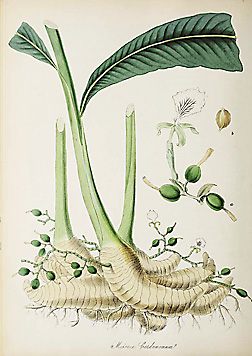Cardamom Takes the Kake
By Audrey Stallsmith

. . .cardamom coffee, known as “gahwa,” was a symbol of hospitality, served and received with ritual. You are supposed to drink at least three cups, audibly slurping, before any business transpires. . .
CRC Handbook of Medicinal Spices—James Duke
No, the “kake” in the title of this article isn’t a misspelling. The cardamom I briefly mentioned last month as a spice in my gingersnaps also is a key ingredient in the Scandinavian Julekake. Although that Yule treat contains candied fruit, it actually is a bread rather than cake. Cardamom also appears frequently in other Scandinavian sweet breads and butter cookies.
A member of the ginger family, cardamom also grows from a rhizome and is hardy only in USDA zones 10 through 12. I have some plants which I received in a trade, but mine are packed so tightly into a pot that they seldom surpass a few inches in height and never bloom.
In tropical climes, they can reach 6 to 15 feet, growing best in partial shade and wet conditions, and producing at their bases white flowers with burgundy veining. (The more exotic looking partially furled yellow and red flowers often pictured as cardamom appear to be some type of Alpinia instead, probably calcarata which also is known as false cardamom!) Black cardamom grows to about 5 feet and makes yellow flowers, also with darker veining.
The plants’ pods often are picked and sold unopened, since the flavor of the seeds will be best if they are ground immediately after being removed from those pods. However, you can buy already ground cardamom as I did. My favorite chai (spiced tea) contains it, and it is a popular flavoring for coffee in the Mideast, as well as being an ingredient in many curry powders.
Cardamom also has been recommended as a remedy for painful urination and obesity, since it revs up metabolism and helps expel excess water. It also is believed to have a cooling effect and to relieve indigestion.
And, of course, it flavors Christmas--at least in some parts of the world! How it got to Scandinavia, nobody knows for sure, but there is speculation that the Vikings brought it back from Constantinople in the 10th century when the emperor there employed them as bodyguards.
Since cardamom always has been one of the more expensive spices, perhaps the Magi carried it with them to Bethlehem along with frankincense and myrrh. After all, tradition holds that Gaspar was from India. At any rate, it makes a good excuse for us to flavor our Christmas cookies with one of the spices of the east.
The Elettaria cardamomum image is from Plante Utiliores by G. T. Burnett, courtesy of plantillustrations.org.








